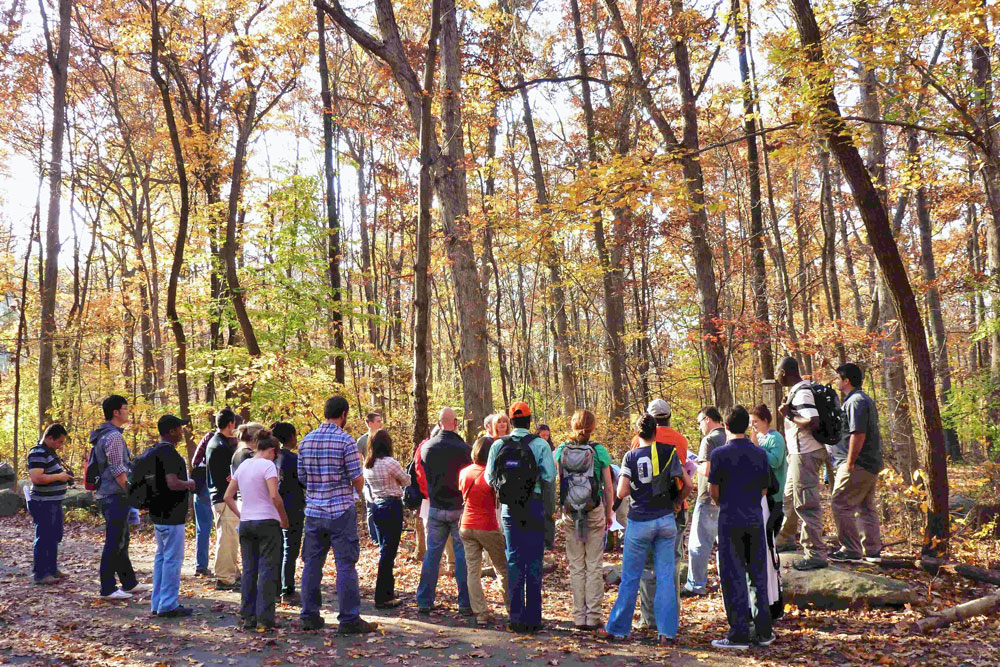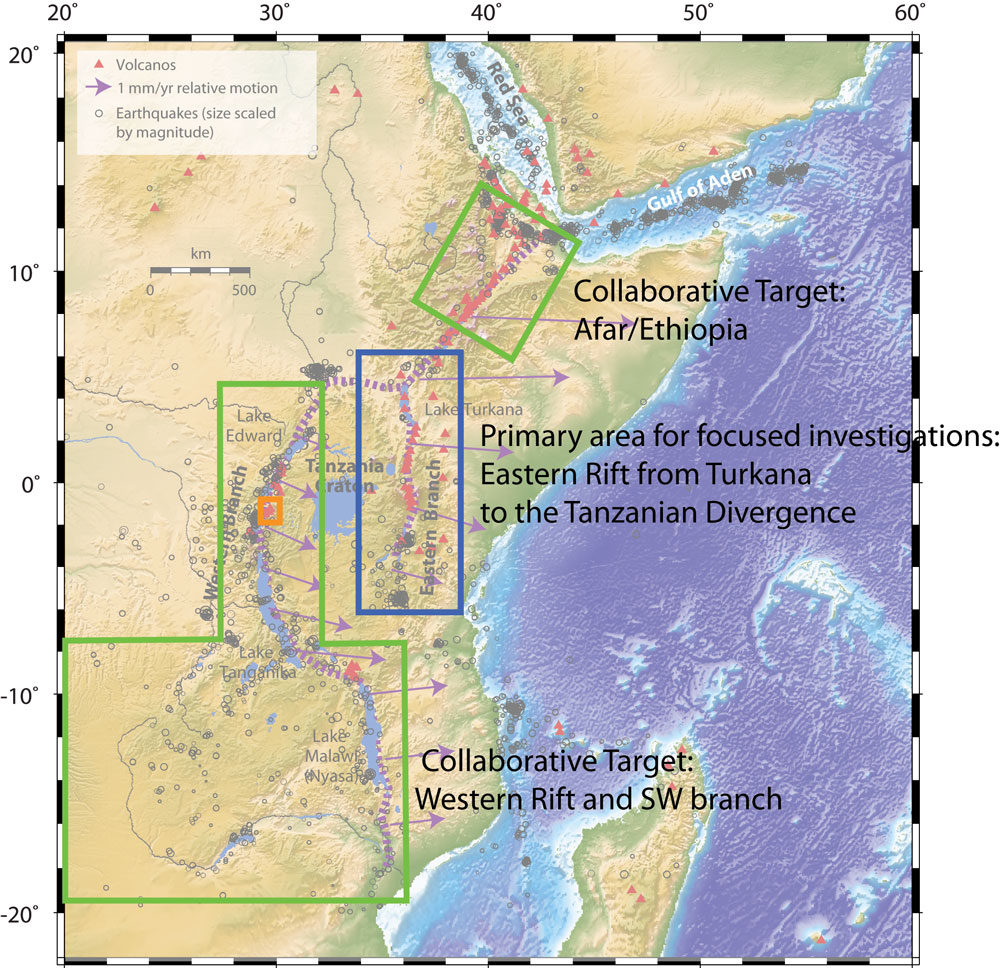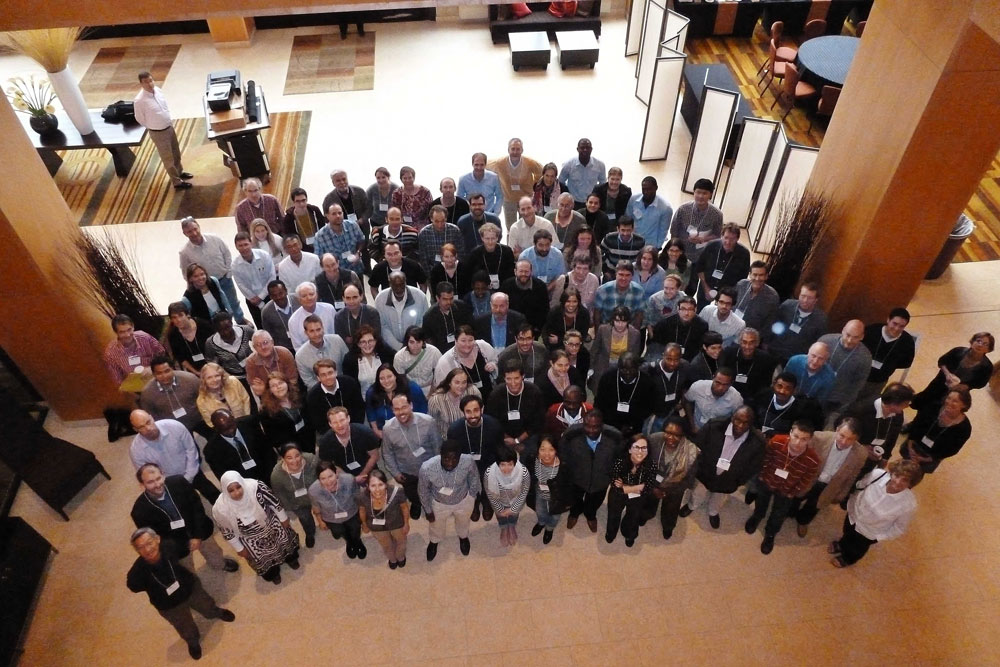Morristown, NJ – October 25 – 27 2012
1Arizona State University; 2Oklahoma State University; 3The College of New Jersey; 4University of Arizona; 5WHOI; 6Cornell University; 7Michigan State University; 8Lamont Doherty Earth Observatory
Background and Motivation
The planning workshop for the East African Rift System (EARS) GeoPRISMS primary site was held in Morristown, NJ, on October 25-27th 2012, mere days before Hurricane Sandy made landfall. An international group of ~115 attendees took part, including a gratifyingly large number of graduate students (~40). Overall, 15 different countries were represented, with a large number of participants from several African countries, including Tanzania, Uganda, Kenya, Ethiopia, Malawi, and the Democratic Republic of Congo (figure 1).
The East African Rift System was chosen as a primary site for GeoPRISMS because it offers significant opportunities to study a wide range of questions outlined in the GeoPRISMS Science Plan for the Rift Initiation and Evolution (RIE) Initiative, as outlined in the GeoPRISMS Science Plan and the Draft Implementation Plan (http://www.geoprisms.nineplanetsllc.com/science-plan.html); these documents served as the starting point for this workshop.
The main goals of the workshop were to clarify the community research objectives in the EARS, to discuss candidate focus areas for concentrated research, to identify opportunities for international partnerships, and to develop a detailed Implementation Plan for GeoPRISMS research in EARS to guide GeoPRISMS proposers and reviewers, considering the available resources and infrastructure.

Figure 2. Students gathed around Roy Schlische and Martha Withjack, from Rutgers University, leaders of the student field trip in the Newark Basin
Student Symposium
Prior to the formal meeting, a student symposium was organized by Maggie Benoit (The College of New Jersey). Interested students were given an introduction to the East African Rift System and associated projects, a chance to present their own research to their peers, and an opportunity to meet some of the meeting conveners in an informal setting. More than just providing information on the existing state of knowledge in the region, this event facilitated team building and critical thinking, which allowed the student participants to produce a well-thought out plan of their own during the formal meeting. A field trip to the Newark Basin, led by Martha Withjack and Roy Schlische (both of Rutgers University), visited some local rift features (figure 2).

Figure 3. Workshop attendees participate in post-workshop field trip to the northern part of the Newark Basin.
Post-workshop field trip
The day after the workshop, Paul Olsen, from LDEO, led a field trip for all interested workshop attendees, exploring the northern part of the Triassic-Jurassic Newark basin. This trip provided an overview of this ancient rift basin, analogue to the active East African Rift basins, highlighting similarities and major differences between the two systems (figure 3).
Workshop Plan
The planning workshop itself was structured around 5 key questions from the RIE component of the GeoPRISMS science plan pertinent to the East African Rift. Talks were organized around these topics to give the audience an overview of what is known of the rift system and, more critically, what remains unknown. Presentations from selected talks below are available on the GeoPRISMS website (figure 4).
- Seismological imaging of plumes and associated magmatism in rifts – Gabriel Mulibo and JP O’Donnell.
- Origin of magmas from geochemical perspective – Tyrone Rooney
- Plume dynamics and surface uplift – D. Sarah Stamps
- Mechanisms for thinning the lithosphere, including thermal/chemical erosion, and interaction with large scale lithospheric structures –Ben Holtzman
- Control of pre-existing structures on early rifting –Aubreya Adams
- Geochemical heterogeneity of the lithosphere – Wendy Nelson
- Magmatism during rifting events – David Ferguson
- Modeling and observations of faulting and magmatism during rifting – Juliet Biggs
- Active deformation processes – Becky Bendick
- Geochemical studies of magmas and volatiles – Tobias Fischer
- Geophysical imaging of magmas and fluids (MT, seismic): Derek Keir
- Shallow dynamics of magma chambers/dikes and eruptions – Manahloh Bechalew
- Climate and tectonics and feedbacks – Manfred Strecker
- Modeling perspective – Joellen Russell
- Tectonics and sedimentation at basin scale – Chris Scholz
- Seismic hazard – Ataley Ayele
- Volcanic hazard – Nicolas d’Oreye
- Oil/gas exploration – Dozith Abeinomugisha
Topic 7: Synergies with other agencies / international projects
Topic 8: African partnerships panel
Break-out discussions were interspersed with the plenary sessions, enabling more focused discussions about potential topics of future research. Breakout sessions on Day 1 focused on identifying the most compelling science, the highest priorities for GeoPRISMS program funds, and which types of experiments or observations might be needed. Participants were also asked to identify which themes, if any, require focusing of effort with concentrated, collaborative investigations at specific sites.
Recognizing that the East African Rift offers significant broader impacts, both in terms of hazards and resources, and in terms of education and capacity building opportunities, plenary sessions were organized to cover these topics. A session at the end of Day 1 focused on seismic and volcanic hazards, as well as opportunities that might arise from oil and gas exploration activities. On Day 2, a panel of African colleagues gave valuable insights into what needs to be considered when entering into partnerships with scientists in African nations, and thoughts on how to build successful collaborations.
The conveners also recognized that work in EARS will require PIs to initiate international collaborations and, in some cases, seek funds from other programs at NSF and elsewhere, in order to accomplish their goals, and the goals of the GeoPRISMS Program. Overviews of existing programs and other opportunities for funding were given both by invited speakers and through “pop-up”, sessions in which participants were given the opportunity to express their own thoughts and interests to the meeting. Student participants were also given the opportunity to highlight their own work through brief “pop-up” presentations.
Breakout sessions on Day 2 started to focus in on identifying target areas where the key questions could best be addressed, with the aim of narrowing in on a few locations. In addition, the student participants organized an additional session in the evening (and into the early hours) distilling the information they had gained throughout the workshop, into a decision matrix which they presented on Day 3. The final breakouts attempted to gauge interests in the various sites identified as candidates for focused effort.
Workshop Outcomes
Shortly following the meeting, the conveners distilled the feedback and outcomes of all the discussions and identified the following as the potential areas for GeoPRISMS effort (figure 6).
Primary focus area: The Eastern Rift, The Eastern Branch of the EARS was identified in breakout groups and by the graduate students as a location where a focused inter-disciplinary effort could substantially impact our understanding of rift processes and effectively address the majority of the science questions that form the core of the science plan. This region would encompass the rift from the Tanzanian divergence in the south to Lake Turkana and southern Ethiopia to the north. Particular opportunities highlighted by discussion and relevant to the science plan include (but are not limited to) the role/origin of a plume in this part of this rift; the interaction of the rift and plume with major lithospheric structures; an active magmatic system; along-strike variations in the amount of cumulative extension and lithospheric thickness (from thin in the north to thick in the south); the preservation of a record of the interplay of climate and tectonics. The existing studies characterizing this region provide a rich framework upon which GeoPRISMS science will build.
The conveners also identified what they termed “Collaborative Targets of Opportunity” where we recognize that efforts have been ongoing, offering leveraging opportunities for future programs.
Target 1: The Afar and Main Ethiopian Rift. This part of the rift system is the focus of intense recent and ongoing international and US efforts. Further GeoPRISMS studies that could enhance our understanding of rifting processes include (but are not limited to) efforts that examine strain localization, and studies probing the origin and role of a plume in rifting. The recent rifting and eruption in this region allows studies of active processes.
Target 2: The Western Rift and SW branch. This site would provide the opportunity to examine the role of magmatism in rifting by comparing this comparatively less magmatic system with the highly magmatic Eastern Rift. It also contains the most weakly extended portions of the rift and thus can be used to tackle questions concerning incipient rifting. Finally, deep lakes along the Western Rift contain the longest continuous record of climate/tectonic interactions available for the EARS. New GeoPRISMS studies in this area can leverage recently funded NSF programs and other previous and ongoing tectonic and climate investigations.
Target 3: Synoptic investigations along the entire rift. As identified in many discussions at the workshop, there are questions in the science plan that are best addressed by examining the rift as a whole. These concern rift-wide variations in the origin and timing of volcanism, the strain field along and across the rift and large scale structure and dynamics underpinning the rift system. Thus, key components of the implementation plan should include broad and open data assimilation efforts, strategic infilling of climatic, geochemical, and geophysical observations, and modeling and experimental work, which would provide a framework for the focused investigations along the rift.
The workshop conveners are currently in the process of wrapping up the first draft of the GeoPRISMS implementation plan for the East African Rift System primary site, which then will be disseminated to the community for input. The conveners thank all participants for their attendance and input to this plan, and the GeoPRISMS Office for coordinating a successful workshop.

Figure 5. A map of the East African Rift System (EARS) highlighting the primary focus area and the Collaborative Targets of Opportunity discussed in the Implementation Plan.comes attendees and introduces the GeoPRISMS Program.


